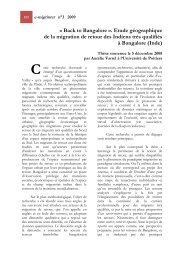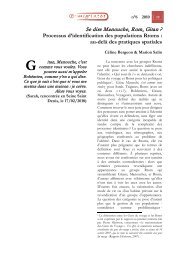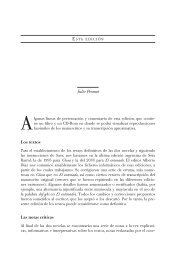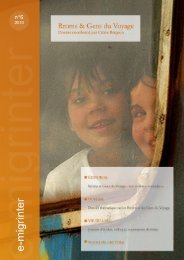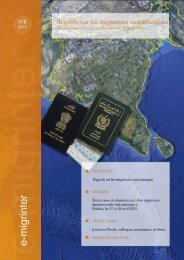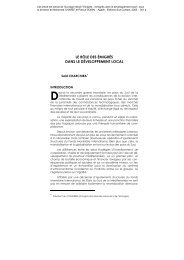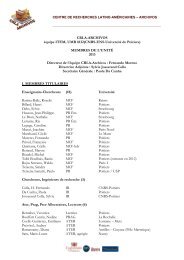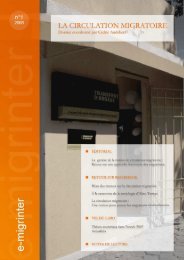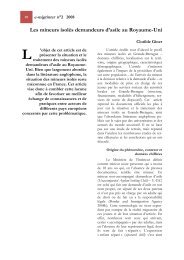e-migrinter 2010 numéro 05 - Maison des Sciences de l'Homme et ...
e-migrinter 2010 numéro 05 - Maison des Sciences de l'Homme et ...
e-migrinter 2010 numéro 05 - Maison des Sciences de l'Homme et ...
You also want an ePaper? Increase the reach of your titles
YUMPU automatically turns print PDFs into web optimized ePapers that Google loves.
60 n°5 <strong>2010</strong><br />
They are global nomads, free spirits who<br />
supposedly go wherever they please, as<br />
opposed to nomads of global economy (Trux,<br />
2002:181) who follow employment<br />
opportunities. In this sense the term also<br />
juxtaposes them against the ‘typical’<br />
immigrant, which in laymen’s terms implies<br />
a longer stay often not of one’s own choice<br />
(i.e. humanitarian immigrants).<br />
‘Skilled migrants’ is not without its<br />
problems either. First of all, measuring who<br />
is ‘skilled’ is difficult. Levels of education<br />
have often been used as measurement, but<br />
they are seldom inclu<strong>de</strong>d in national<br />
statistics on immigration. Furthermore,<br />
appreciation for certain skills is <strong>de</strong>pen<strong>de</strong>nt<br />
on need. Is a construction worker or a nurse<br />
then any less skilled than a biotechnology<br />
expert or an IT engineer? The final report of<br />
the Global Commission for International<br />
Migration even suggests that: the traditional<br />
distinction b<strong>et</strong>ween skilled and unskilled workers is<br />
in certain respects an unhelpful one […] While they<br />
may have different levels of educational achievement,<br />
all of them could be legitimately <strong><strong>de</strong>s</strong>cribed as essential<br />
workers (20<strong>05</strong>:7).<br />
Calculating skilled migrants from<br />
statistical data is ma<strong>de</strong> difficult because of<br />
their ‘invisibility’. Skilled migrants cannot be<br />
i<strong>de</strong>ntified by gen<strong>de</strong>r, age, nationality,<br />
language or religion. They also cannot be<br />
<strong>de</strong>fined by educational status, visa type or<br />
employment status alone. Many are not even<br />
registered resi<strong>de</strong>nt in the country where they<br />
work because of employment contracts that<br />
keep them in two or more countries. In<br />
addition, those who arrive to a country as<br />
immigrants but later acquire citizenship g<strong>et</strong><br />
lost in the statistics. The most<br />
comprehensive attempt so far to shed light<br />
on these issues and to combine national<br />
statistics is a 20<strong>05</strong> OECD working paper<br />
(Dumont and Lemaître, 20<strong>05</strong>).<br />
Still, actual numbers are hard to<br />
provi<strong>de</strong>. Immigration to Finland for work<br />
reasons is estimated to account for around<br />
10% of the total immigration flow<br />
(Forsan<strong>de</strong>r <strong>et</strong> al, 2008). For the purposes of<br />
this article, skilled migrants should be<br />
viewed as an umbrella term; many of them<br />
may be (or may have been originally)<br />
expatriates, most are certainly international<br />
(if not internationals), all are immigrants, and<br />
some might even i<strong>de</strong>ntify themselves as<br />
‘transient’ and ‘global’.<br />
Case studies<br />
Whereas previous migrants arrived<br />
into Finland mainly due to humanitarian<br />
reasons and were therefore seen as a moral<br />
issue, skilled migrants are primarily seen as<br />
an economical concern. Much of research<br />
has followed this logic. Studies have<br />
concentrated largely on the legislative and<br />
economic issues of skilled migration (e.g.<br />
Kananen, 2006; Forsan<strong>de</strong>r, 2002), or on<br />
finding out how employers can b<strong>et</strong>ter attract<br />
foreign workforce (e.g. Trux 2000; Sippola <strong>et</strong><br />
al, 2006). Little is known about the social<br />
aspects and the actual experience of living in<br />
Finland as a skilled migrant. As is argued,<br />
this type of research is paramount for<br />
attracting and later committing skilled<br />
migrants to Finland.<br />
The following is therefore an overview<br />
of case studies that have taken into<br />
consi<strong>de</strong>ration also life outsi<strong>de</strong> the workplace.<br />
Reading b<strong>et</strong>ween the lines of these studies<br />
shows that Finland’s supposed trump cards<br />
of high quality of living standards, saf<strong>et</strong>y and<br />
nature are not strong enough pull-factors for<br />
attracting, and certainly not for committing,<br />
skilled migrants to Finland. Furthermore,<br />
they imply that the social sphere is where<br />
most problems are felt and that it is<br />
consi<strong>de</strong>red very important when <strong>de</strong>ciding<br />
weather to stay on in Finland or not.<br />
Finland in the ‘global field of choices’:<br />
the pull factors<br />
One of the only long-term researchers<br />
of skilled labour migrants in Finland is Mika<br />
Raunio. Although much of Raunio’s<br />
research is also from the point of view of



